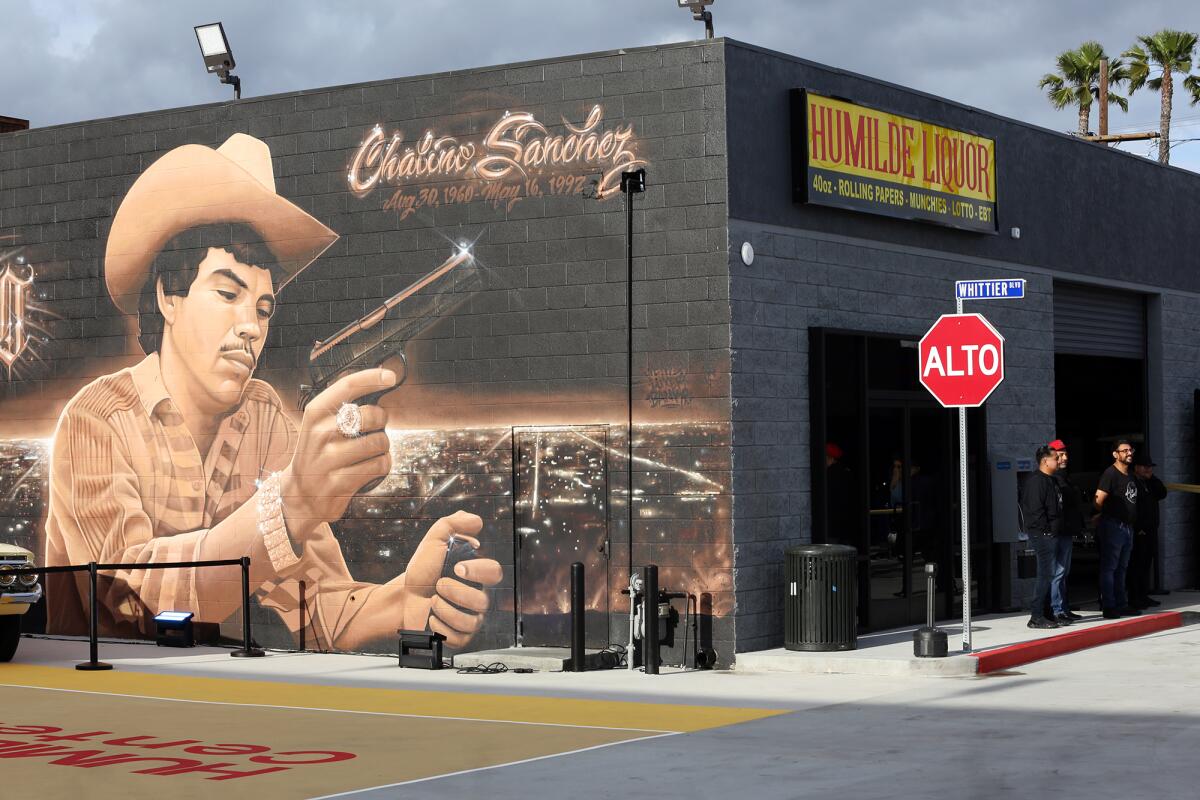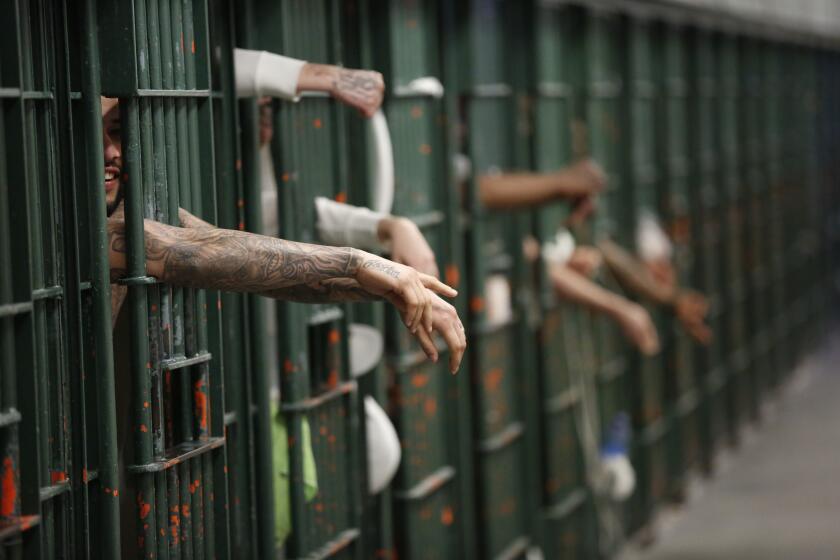30 beers, a cockfight, a gun: The untold story of the man who tried to kill Chalino Sanchez

- Share via
Edward Alvarado Gallegos cast his mind back three decades, to the night in 1992 that he tried to kill a legend.
After clambering drunkenly onto the stage of a nightclub, he stood face to face with the singer Chalino Sanchez. Both men had traveled similar paths. Like Chalino, Gallegos was a teenager when he left his home state of Sinaloa, where his family worked the fields in poverty. Gallegos was looking for “the American dream, to earn money,” he would say decades later. It didn’t turn out that way.
Chalino found fame and fortune in the dance halls of southeastern Los Angeles County, singing corridos — ballads that chronicled the lives of men who made a living sending drugs, money and people across the U.S.-Mexican border. Gallegos was broke, addicted to heroin, and losing his marriage when he invited himself onstage at the Plaza Los Arcos in Coachella.
Gallegos pointed a gun at Chalino’s chest and pulled the trigger four times. Chalino drew his own gun and fired back. Pandemonium erupted. A young man, dancing with his wife, was fatally wounded in the crossfire.
Chalino eluded death that night, but it was only a reprieve. Four months later, his body was found dumped in a canal in Sinaloa. His murder, which has never been solved, cast the earlier shooting in a new light: Was that chaotic night in Coachella the handiwork of a drunken patron, or was Gallegos a hired gun for some trafficker Chalino had angered?
Gallegos was sentenced to 20 years to life, but it wasn’t until 2012, when he was first up for parole, that he spoke about the night he tried to kill Chalino. At that hearing and subsequent ones in 2017 and 2022, reported here for the first time, Gallegos recounted his life leading up to the shootout at Plaza Los Arcos and told two contradicting stories of why he shot the singer.
After 31 years behind bars, Gallegos, 64, was released from prison on May 9, according to a spokeswoman for the California Department of Corrections and Rehabilitation. He faced deportation to Mexico, but his current whereabouts are unknown and neither he nor his family could be reached for comment.
Chalino’s legend has only grown with the passage of time. The night at Plaza Los Arcos made him known as a man who did not just sing of gunfights but won them. His murder remains an enduring mystery. The theories of who wanted him dead, and for what reasons, are too numerous to count.
Until his murder in prison two weeks ago, Michael Torres ran one of the most intricate and lucrative black market businesses in L.A. County: the jails.
If Chalino’s fans believed Gallegos could offer some clue as to who ultimately had the singer killed, there are none in the transcripts of his parole hearings, which raise as many questions as they answer. Like so much of Chalino’s life, the story Gallegos told of that night has changed over time.
“So we’re left wondering,” a prosecutor remarked, “what is the truth?”
Gallegos was born to a poor family of eight children, he told the parole board. He said his family owned a plot of land in Navolato, about 20 miles west of Culiacán, the Sinaloan capital.
Beginning in the third grade, Gallegos would spend the first half of the day in school and the rest working with his parents in the fields, he said. He dropped out in the sixth grade to work full-time. Gallegos described his family as “dysfunctional,” recalling a childhood “with a lot hurt, with a lot of pain.”
“When you can’t do anything,” he said, “you feel angry and resentful and you feel — feel powerless.”
At 14, Gallegos said, he followed his older brothers to the Coachella Valley. He picked crops and later worked as a mechanic in Indio, fixing junked cars and selling them, he said. He was deported several times but never waited more than a few days before returning illegally to the United States, a parole commissioner said.
By 17, Gallegos was drinking two six-packs of beer a day, starting a spiral of addiction that he blamed for the fraying of his marriage, the shootout with Chalino, and the loss of his freedom. He drank, he said, to forget he didn’t have enough money to pay his bills.
“Everyone out on the streets has problems,” he told the board in 2012. “And we start drinking to avoid the daily problems. But the next day, the problems are still there. Nothing gets resolved.”
After four years of slugging beer and tequila, “your body asks for something stronger,” he said. He started snorting heroin. Before long, he was injecting it.
A father of two, Gallegos spent everything he earned on booze and heroin, he said. His marriage to a woman he’d met as a teenager was falling apart. She would divorce him after he went to prison, he said.
On the day he shot Chalino, Gallegos said, he started the morning with a beer, then went to a cockfighting match. By the time he got to Plaza Los Arcos that night, he had drunk 30 beers and shot heroin, he said. He was carrying a pistol he’d bought from a “paisa” who had gone back to Mexico, he told the board.
It was his first time seeing Chalino perform. “I had only heard and listened to his music,” he said, “because he sings corridos.”
Gallegos may not have known it, but Chalino had taken a similar path to the United States. Raised on a small Sinaloan rancho, Chalino — born Rosalino Sanchez — crossed the border in 1977, four years after Gallegos. He too found work in the fields of the Coachella Valley.
Chalino began selling small amounts of marijuana and cocaine and helping his brother, Armando, smuggle people across the border, Sam Quinones wrote for the LA Weekly in 1998. After Armando was shot to death in a Tijuana hotel, Chalino wrote his first corrido in his brother’s memory.
By the time he took the stage at Plaza Los Arcos, Chalino had found an audience: drug traffickers who paid him — sometimes in cash, sometimes with a watch or a pistol — to trace the arcs of their short lives in song. His music also appealed to legions of Southern California teenagers who were not from the narco world but found themselves enthralled by his stories of gunfights, betrayals and vendettas.
A cowboy hat perched on his head, a handgun more often than not tucked in his waistband, Chalino sold out clubs such as El Parral in Southgate and El Farrallon in Lynwood. That night in Coachella, 400 people had crowded into Plaza Los Arcos. Somewhere in the crowd was Gallegos, who would offer to the parole board two very different accounts of his actions that night.
At his first hearing in 2012, Gallegos said he merely wanted to hand Chalino his gun so he could fire it onstage as he sang, “just like they do in Mexico.”
“But what happened was that the singer got scared,” he said, “and I didn’t know that he had a gun also.” Gallegos claimed he and Chalino began shooting at the same time.
Rene Carranza, 20, had been dancing with his 18-year-old wife when a bullet pierced an artery in his thigh. Carranza, father to a 2-month-old baby, bled to death. Six others, including Carranza’s wife, were shot but survived.
“I feel bad for what I did,” Gallegos told the board in 2012, “but you can’t fix anything by feeling like that.”
Five years later and again in 2022, Gallegos told a different story. Before taking the stage, Gallegos said, Chalino passed by his table. He asked the singer to perform a particular song and “send some greetings to some people whom I knew from another town.” Chalino agreed, Gallegos told the board.
But as the night wore on and the song Gallegos had wanted to hear wasn’t played, “I started feeling irate,” he said. “Because, you know, the thing is that I was feeling ignored.”
After climbing onstage, Gallegos said, he fired four shots at Chalino from about three feet away. The singer drew his own gun and fired once at Gallegos. It jammed, and Chalino threw the gun at Gallegos’ face, a parole commissioner said.
Gallegos was dragged offstage and wrestled to the ground. Someone in the crowd took the gun from him and shot him in the mouth.
Anna Laura Costa Porsborg came to Los Angeles last Christmas Eve for a weeklong vacation. Authorities do not believe she ever left. Her remains, they suspect, are somewhere in the Angeles National Forest.
Parole commissioners and prosecutors from the Riverside County district attorney’s office said they did not entirely believe either story.
“Eight people were shot because this inmate says the singer didn’t play a song he wanted,” Deputy Dist. Atty. Terri Wyatt said in 2022. “That’s ridiculous, senseless, violent, and I don’t think we’re getting at the exact motive here.”
Noting that Chalino was murdered four months later, Commissioner William Muniz asked Gallegos if he went to Plaza Los Arcos intending to kill him.
“No, I didn’t even know who he was,” Gallegos said, contradicting his earlier statement that he knew of Chalino but had never seen him perform. “I was just going to listen to him, to sing, but I — I didn’t know him.”
Unlike at his hearing a decade earlier, Gallegos admitted in 2022 that he tried to murder Chalino and said he was responsible for the death of Carranza, whether he fired the shot that killed him or not. “Even though it took me so long,” he said, “I now understand that I have a moral responsibility to be responsible of my crime.”
In weighing whether to grant Gallegos parole, the board considered not only his crimes but his record in prison. Gallegos had been written up for smoking tobacco, possessing sewing needles and nails, and damaging state-issued clothing, according to his parole transcripts.
But the board noted he hadn’t been disciplined since 2017 and looked favorably on his work record, which included jobs as a printer, porter, landscaper and dining room attendant. Gallegos said he’d been sober since his arrest in 1992, and the board saw no evidence to disprove that.
“You clearly have demonstrated change,” Muniz told him.
Mary Xjimenez, a spokeswoman for the state corrections department, declined to say whether Gallegos was turned over to immigration authorities for deportation after he was released in May. Gallegos told the board he wanted to return to Sinaloa, where his father still lived on their family’s plot of land.
If deported, he swore never to come back.
“A human being that has spent 20, 30 years in prison in the United States,” he said, “the only thing that person wants is to go back to his or her country and spend the last years of their life with their family. Because there’s nothing here for me but prison, I — I just want to go.”
More to Read
Sign up for Essential California
The most important California stories and recommendations in your inbox every morning.
You may occasionally receive promotional content from the Los Angeles Times.















